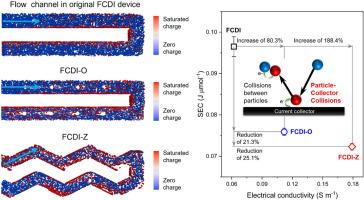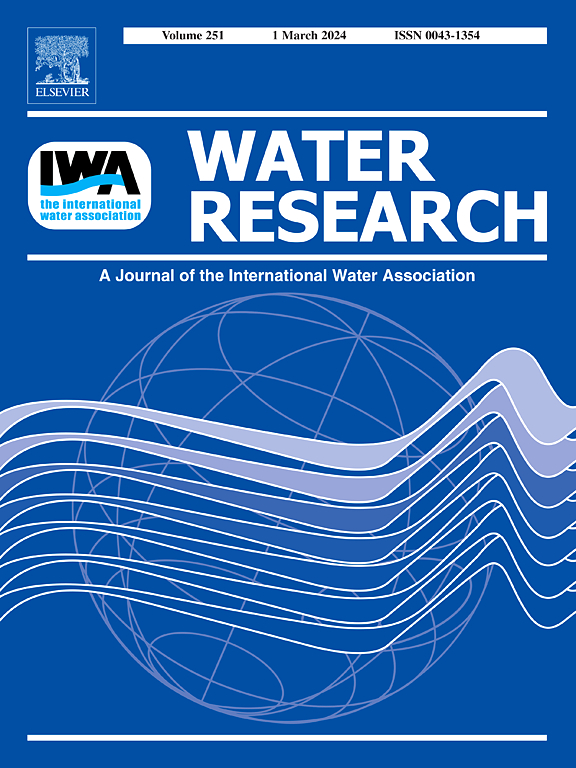IF 11.4
1区 环境科学与生态学
Q1 ENGINEERING, ENVIRONMENTAL
引用次数: 0
摘要
流动电极电容式去离子(FCDI)是一种简单而高效的海水淡化技术,但由于流动电极的高电阻而受到高能耗的限制。在这项研究中,我们使用基于 CFD-DEM 的两相流模型模拟了流动电极内的碰撞和电荷转移过程。该模型准确模拟了长直管道和蛇形通道中的流动电极在不同流速和碳负载条件下的电导率,揭示了粒子-集流碰撞在电极电导率中起着决定性作用。基于这些发现,我们提出了两种优化的流道,以增加碳颗粒与集流板之间的有效碰撞:一种是带有中心圆柱形障碍物的蛇形流道(FCDI-O),另一种是人字形流道(FCDI-Z)。结果表明,与最初的 FCDI 蛇形通道相比,FCDI-O 和 FCDI-Z 都能显著提高流电极电导率(FCDI-O 为 80.4%,FCDI-Z 为 188.3%),并降低海水淡化能耗(FCDI-O 为 21.3%,FCDI-Z 为 25.1%)。我们使用稳态电化学模型进一步分析了 FCDI 各组件的能耗分布。结果表明,在不同的工作条件下,FCDI-Z 通道的总能耗都有所下降,而且流电极的能耗比例低于 FCDI-O 通道。然而,在 FCDI 海水淡化过程中,流电极仍然是最大的能耗者。这项研究为 FCDI 海水淡化新流道的开发和实际应用提供了宝贵的见解。本文章由计算机程序翻译,如有差异,请以英文原文为准。


Two-Phase flow model-driven optimization of charge percolation in flow-electrode capacitive deionization
Flow electrode capacitive deionization (FCDI) is a simple and efficient desalination technology but is limited by high energy consumption due to the high resistance of the flow-electrode. In this study, we simulated the collision and charge transfer processes within the flow-electrode using a CFD-DEM-based two-phase flow model. The model accurately simulated the conductivity of flow-electrodes in both long straight and serpentine channels under various flow rates and carbon loadings, revealing that particle-collector collisions play a decisive role in electrode conductivity. Based on these findings, we proposed two optimized flow channels to increase the effective collisions between carbon particles and collector plates: a serpentine channel with a central cylindrical obstacle (FCDI-O) and a zigzag-shaped channel (FCDI-Z). The results demonstrate that both FCDI-O and FCDI-Z significantly enhance flow-electrode conductivity (80.4% for FCDI-O and 188.3% for FCDI-Z) and reduce desalination energy consumption (21.3% for FCDI-O and 25.1% for FCDI-Z), compared to the original FCDI serpentine channel. We further analyzed the energy consumption distribution across FCDI components using a steady-state electrochemical model. The results indicate that, under various operating conditions, the total energy consumption decreases, and the proportion of energy consumed by the flow-electrode is lower in the FCDI-Z channel than in the FCDI-O channel. However, the flow-electrode remains the largest energy consumer in the FCDI desalination process. This study provides valuable insights for the development and practical application of new flow channels for FCDI desalination.
求助全文
通过发布文献求助,成功后即可免费获取论文全文。
去求助
来源期刊

Water Research
环境科学-工程:环境
CiteScore
20.80
自引率
9.40%
发文量
1307
审稿时长
38 days
期刊介绍:
Water Research, along with its open access companion journal Water Research X, serves as a platform for publishing original research papers covering various aspects of the science and technology related to the anthropogenic water cycle, water quality, and its management worldwide. The audience targeted by the journal comprises biologists, chemical engineers, chemists, civil engineers, environmental engineers, limnologists, and microbiologists. The scope of the journal include:
•Treatment processes for water and wastewaters (municipal, agricultural, industrial, and on-site treatment), including resource recovery and residuals management;
•Urban hydrology including sewer systems, stormwater management, and green infrastructure;
•Drinking water treatment and distribution;
•Potable and non-potable water reuse;
•Sanitation, public health, and risk assessment;
•Anaerobic digestion, solid and hazardous waste management, including source characterization and the effects and control of leachates and gaseous emissions;
•Contaminants (chemical, microbial, anthropogenic particles such as nanoparticles or microplastics) and related water quality sensing, monitoring, fate, and assessment;
•Anthropogenic impacts on inland, tidal, coastal and urban waters, focusing on surface and ground waters, and point and non-point sources of pollution;
•Environmental restoration, linked to surface water, groundwater and groundwater remediation;
•Analysis of the interfaces between sediments and water, and between water and atmosphere, focusing specifically on anthropogenic impacts;
•Mathematical modelling, systems analysis, machine learning, and beneficial use of big data related to the anthropogenic water cycle;
•Socio-economic, policy, and regulations studies.
 求助内容:
求助内容: 应助结果提醒方式:
应助结果提醒方式:


